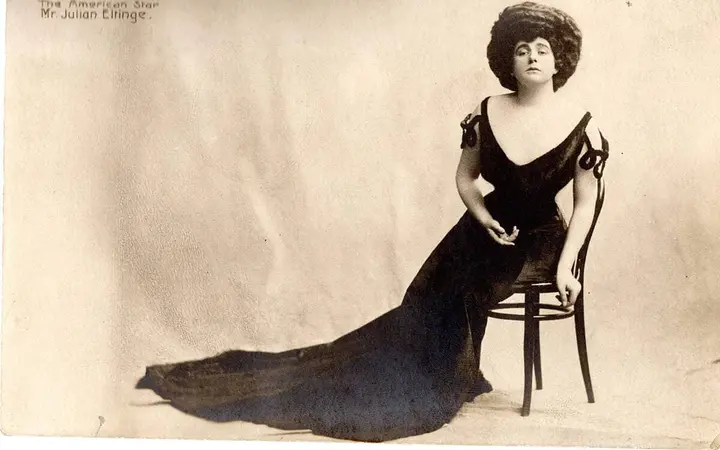Julian Eltinge: America’s incredibly famous female impersonator and his life in Northport

This is an introduction to the life of Julian Eltinge, famous drag queen and resident of Fort Salonga, written by Northport Historical Society Museum Educator Ceylan Swenson. Ceylan will be giving a more detailed lecture about Julian’s time in Northport this Sunday, June 26.
At the Northport Historical Society, we celebrate the incredible lives of everyday people, and honor the complexity of their identities and experiences. But we can also count quite a few famous people who have come to live quiet lives in our community over the years. You may be familiar with some of their names, like Booker T. Washington, Jack Kerouac, and Rube Goldberg, but I’d wager a bet that you hadn’t heard of Julian Eltinge. After decades of obscurity, Julian’s life story has begun to see a resurgence of popular interest, especially among vaudeville and LGBT researchers.
Julian Eltinge is widely considered to be America’s first world-famous female impersonator. This bona fide theater and movie star had a residence in Fort Salonga between 1908 and 1914. At the height of his fame, he worked with actors like Rudolph Valentino – and Julian was the headliner. But by the time he passed away in 1941, Julian had been pushed out of the performance industry by homophobic laws and left behind by the cultural zeitgeist.
Julian was a very private person who carefully guarded his secrets. We have little conclusive evidence as to Eltinge’s sexual orientation. He vigorously asserted his personal masculinity in attempts to counteract rumors of homosexuality, but after he died his contemporaries claimed he had male lovers. As a person who challenged and reinforced gender stereotypes and images, Julian Eltinge is a key part of the history of queer representation in America’s history.

Eltinge was famous for his naturalistic imitation of Victorian femininity. Photo courtesy of the Northport Historical Society.
Julian was born William Dalton in 1881 in Massachusetts. Biographers mostly agree that the Dalton family moved to Butte, Montana while Julian was young. Popular legend tells us that Julian started performing drag in Butte, possibly with his mother’s support and father’s disapproval. After moving back to Boston, Julian found his way into playing the role of female ingenues in all-male theatrical performances. Good reviews for those performances created a springboard from which he jéted down to New York City. He had his first headline role on Broadway in 1904, at age 23.
Between 1904 and 1908, Julian’s acclaim was growing. By all accounts, he was a good actor and singer, but part of his appeal as a female impersonator was his uncanny ability to imitate idealized Victorian femininity. When acting out female parts, he was demure, graceful, and natural. His performance of femininity, costumes, and makeup were so good that audiences at his vaudeville revues consistently didn’t realize he was a man until he would dramatically take off his wig at the end of his acts.
Julian’s physical drag wasn’t predicated on the campiness we associate with drag today; it was all about subtlety. His makeup was designed to achieve a natural feminine look. His gowns were extravagant but not avant garde; and most importantly, he did not perform with any references to homosexuality. He satirized the actions associated with femininity, but not the look. In his musical comedies, Julian always played male characters who were forced by unforeseen circumstances to dress up and pass as a woman in order to achieve a goal: get the girl, get the money, avoid the bad guys.
Learn more about Julian’s time in Northport during Ceylan Swenson’s lecture at the Northport Historical Society this Sunday, June 26, at 1pm. The lecture will include images and clips of Eltinge’s performances and a display of the museum’s prized collection of signed Eltinge photos. Secure your free ticket or register on Zoom here.

Rest at Northport: Eltinge had a farm in Fort Salonga from 1908-1914. This postcard calendar shows that he visited in the summer months of 1911. Photo courtesy of the Northport Historical Society.
Don’t miss a story
Get the latest news delivered to your inbox.








